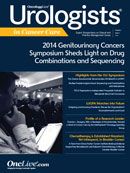Adding Epidural to Anesthesia During Prostatectomy May Improve Long-Term Outcomes in Men With PC
Long-term outcomes for patients with prostate cancer following radical prostatectomy were better when a spinal or epidural pain block was added to general anesthesia during the surgery.
Juraj Sprung, MD, PhD
Senior author of study
Long-term outcomes for patients with prostate cancer following radical prostatectomy were better when a spinal or epidural pain block was added to general anesthesia during the surgery, according to the results of a large, retrospective study published recently in the British Journal of Anaesthesia.
Authors Scavonetto et al found that systemic tumor progression and all-cause mortality were lower in the group given the combined painmanagement strategy during surgery, compared with the group that got anesthesia only. One reason, they postulate, is that the patients given the combination strategy needed fewer perioperative opioids, which might suppress the immune system and thus promote tumor recurrence.
The authors embarked on the study because, in animals, spinal or epidural pain blocks have proven to decrease the need for systemic opioid administration, as well as two other factors that can impair the body’s defenses against cancer: the surgical stress response, and the use of volatile anesthetics.
The team sought to determine whether those dynamics hold true in humans, after smaller studies brought mixed results. Their own study was unique, they wrote, because it relied on the 23,000-patient Mayo Clinic Radical Prostatectomy Registry, one of the world’s largest.
Specifically, their study was designed to investigate whether adding spinal or epidural pain blocks to general anesthesia reduces cancer recurrence, systemic cancer progression, cancer mortality, and all-cause mortality.
Using the prostatectomy registry along with Mayo’s anesthesia database and electronic medical records, the investigators identified patients who had undergone radical prostatectomy for adenocarcinoma between January 1, 1991 and December 31, 2005.
A total of 1642 patients given the combined anesthesia strategy were matched 1:1 with patients who had received general anesthesia alone.
Of the patients given the dual anesthetic strategy, 83% got neuraxial analgesia in the form of a spinal block with morphine, and, less frequently, hydromorphone, the authors specified. Perioperative opioids included morphine, fentanyl, hydrocodone, hydromorphone, meperidine, oxycodone, oxymorphone, propoxyphene, and sufentanil.
“As expected, systemic opioid use was reduced in patients given general/neuraxial anaesthesia, although not entirely eliminated,” the authors wrote.
Follow-up occurred at a median 8.6 years for patients who received the dual anesthetic strategy and a median 9 years for patients given general anesthesia alone.
In a conclusion they deemed their most important, the investigators found that patients given anesthesia alone faced an increased risk of systemic cancer progression (hazard ratio [HR] = 2.73, P <.001). The authors also found that patients given anesthesia alone had a higher risk of prostate cancer mortality (HR = 2.43, P = .048) and greater overall mortality (HR = 1.35, P = .020).
“In our multivariable model that included covariates for individual comorbidities, positive surgical margins, and adjuvant treatment, systemic progression was greater in general anaesthesia- only patients [adjusted HR = 2.81, P = .008], as was overall mortality [adjusted HR = 1.32, P = .047)],” they noted.
While there weren’t enough prostate cancer deaths to conduct the fully adjusted multivariable model, the study showed some evidence (though not statistically significant) that general anesthesia alone was associated with a higher rate of deaths from the disease (HR = 2.2, P = .091), the authors wrote.
The team pointed out some limitations of their study.
“We are unable to attribute which component(s) of neuraxial anaesthesia improved oncological outcomes,” they wrote. “We hypothesize that a reduction in systemic opioids is an important potential component to improved outcome, but this assumption is speculative and other components may have played a role. For example, some local anaesthetics—notably lidocaine—have distinct systemic effects independent from their action on nerve conduction. Another possibility is that patients who received neuraxial anaesthesia would require lower concentration of volatile anaesthetic.”
Their results, they suggested, should be tested in prospective, randomized clinical trials.
Reference
Scavonetto F, Yeoh TY, Umbreit EC, et al. Association between neuraxial analgesia, cancer progression, and mortality after radical prostatectomy: a large, retrospective matched cohort study. British Journal of Anaesthesia. Published online ahead of print, December 16, 2013.




